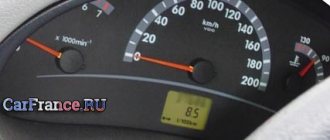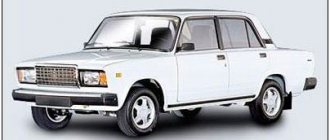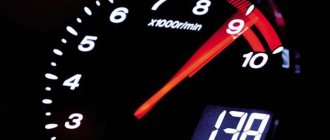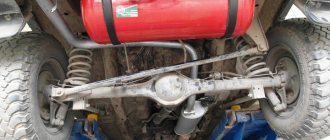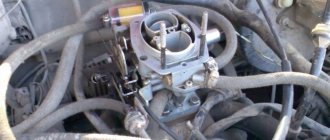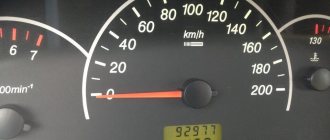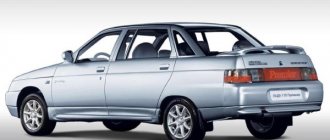My VAZ 2114 (1.5) 2005 with a mileage of 104 thousand uses about 12 liters per hundred in the city, but it’s still November, so what can we expect in winter? But my father’s 14th with a 1.6 engine consumes a stable 8.1 liters per 100 km in the city. And I asked myself: “Why is the fuel consumption so high on my 2114?” And I went looking for an answer on the Internet, as a result of which this article was created
According to the passport, Samara-2 should consume 7.6 liters per 100 km in mixed mode, in the city - no more than 9 liters. If your readings are as high as mine, then it's time to address the increased fuel consumption.
The reason for the high consumption of gasoline, both in VAZ and in other cars, may be the engine management system: it includes an Electronic Control Unit ( ECU , popularly known as the “brains”) and various sensors and drive mechanisms.
Checking the entire engine management system is quite difficult, and it is better to entrust this work to professionals, but if you want to solve the problem yourself, then go for it. Check the mass air flow sensor: Read the article How to check the mass air flow sensor on a VAZ?
The cause of increased fuel consumption can also be a faulty fuel system, namely the fuel pressure in the fuel system (How to check the pressure in the fuel system?):
- Clean/replace the fuel injectors (Cleaning fuel injectors. 4 ways/ How to remove injectors?).
- Replace the fuel pump.
- Replace the fuel filter (Replacing the VAZ fuel filter).
- DS is faulty.
- The phase sensor (PF) is faulty.
- The oxygen sensor (Lambda probe) dies.
- A clogged air filter will increase your fuel consumption by about 3 liters. So it’s better to replace it once again; it costs about 120 rubles. How to replace the air filter?
It also doesn’t hurt to check the following elements:
Increased gasoline consumption may be due to low compression in the engine (How to measure engine compression correctly?). Consumption is also affected by an incorrectly set ignition angle and incorrect valve timing.
At worst, check the tire pressure, they also affect fuel consumption. (What pressure should be in the tires of a car?)
Reasons for high fuel consumption
Most owners note that the gasoline consumption of the car corresponds to the passport data. Sometimes you can come across complaints that the VAZ 2115 has too much fuel consumption, which differs significantly from that indicated in the technical documentation. Experience shows that the increase in the machine’s appetite is explained by specific reasons, among which experts identify:
- Engine condition. It is recommended to undergo maintenance every 10 thousand km with mandatory diagnostics. A drop in compression leads to significant excess fuel consumption.
- Regular cleaning of the fuel supply system. It is better to do this using professional equipment.
- Timely replacement of fuel, air, oil filters.
- Fuel consumption is significantly increased by a faulty chassis and problems with the transmission.
- Low or high tire pressure leads to increased gasoline consumption; in the cold season it is necessary to “change your shoes” to winter tires, this will help save fuel and make driving safer.
- The increase in consumption is influenced by driving style; to reduce it, you do not need to accelerate and brake too actively, keep the engine in the range of 2000-3000 rpm.
REAL PETROL CONSUMPTION ON VAZ MODELS
Real fuel consumption on the VAZ 2114 (as well as on the VAZ 2113 and 2115) often differs from the factory values. Mainly differs in the direction of increase. Of course, a lot depends on weather conditions. In winter, due to long and frequent warm-ups of the car, gasoline consumption increases, and other factors also influence fuel consumption:
- Driving style. Driving with sudden acceleration and high speed does not save fuel;
- Various malfunctions: in the engine, in the ignition system, in the fuel system, etc.;
- Unregulated tire pressure;
- Driving on a cold engine;
- Fuel quality.
Car fuel consumption standards
Gasoline consumption indicators according to the technical passport:
- The fuel consumption rate for a VAZ 2115 (injector) on the highway will be 6 liters.
- In the city, the consumption indicator will indicate 10.4 liters.
- In areas with mixed roads – 7.6 liters.
Real gasoline consumption data
The average fuel consumption of a VAZ 21150 with a manual transmission, engine capacity of 1.6 liters is 7.25 liters on the highway, in the city this figure increases to 10.12 liters, and in mixed mode - 8.63.
Consumption data in cold weather:
- Gasoline consumption in winter on a Lada 2115 will be up to 8 liters on the highway.
- Within the city limits you will have to spend 10.3 liters.
- The mixed view of the road will show the fuel consumption of a 9 liter VAZ.
- Off-road in winter, the car will consume 12 liters.
Actual gasoline consumption of VAZ in summer:
- In summer, on the highway you will need 6.5 liters with a mileage of 100 km.
- The fuel consumption of the car in the urban cycle is 9.9 liters.
- With a mixed route, fuel consumption will correspond to 8.3 liters.
- In off-road conditions, VAZ 2115 gasoline consumption per 100 km increases to 10.8 liters.
These are good data that determine the economy of a domestically produced car and show its advantage over some foreign cars.
Causes of excessive fuel consumption in Lads
Over time, each vehicle can increase its fuel consumption, which can be due to various factors. The main reason is engine wear or clogged spark plugs. Proper care of your vehicle will bring you pleasure from high-quality, safe and economical driving for many years.
It is necessary to strictly monitor the fuel injectors, fuel pump and fuel filter, which primarily suffer during long-term operation and lead to high fuel consumption.
The average fuel consumption at idle for the VAZ 2115 per 100 km is 6.5 liters. This figure may decrease or increase depending on the modification of the car and the year of manufacture. The rate of gasoline consumption at idle speed and electronics turned off is 0.8-1 liter per hour.
According to the passport, the fuel consumption of the VAZ Samara-2 car is 7.6 liters in mixed mode, in the city - no more than 9. If such indicators have increased, then the car owner needs to determine the cause and eliminate it.
A car with an injector and built-in computer technology can easily be tuned, which gives it a more modern look, aesthetic beauty, and more comfortable operation. The above indicators of gasoline costs based on real data and according to the technical data sheet do not have significant differences. It all depends on the care of the car, parking location, and weather conditions.
Despite the fact that the production of this car has already ended, you can see many happy VAZ owners on the roads, which indicates its reliability, high wear resistance, economy in maintenance and fuel consumption. The plant in Togliatti, where the car was produced, has been famous for many years for the high quality of the vehicles produced, which are optimally suited to the conditions of use in our region.
If you find an error, please select a piece of text and press Ctrl+Enter.
VAZ 2115 in detail about fuel consumption
The production of frets of this model began in 1997; they belong to the popular Samara family. Thanks to the technical advantages of the car and the rigor of its design, it has become very popular on the market. Experts also include the fuel consumption of the VAZ 2115 as an advantage.
These reliable cars were produced in large quantities from the factory, and their supply stopped only in 2012 after the appearance of the new Granta model. Many car enthusiasts were never able to say goodbye to the previous modification of the car, so they still continue to use the VAZ with pleasure.
| Engine | Consumption (highway) | Consumption (city) | Consumption (mixed cycle) |
| 1.6 l | 6.3 l/100 km | 10 l/100 km | 7.6 l/100 km |
Specifications
This is an improved model of the well-known VAZ 21099. The sedan that replaced it has become more popular than its predecessor. It features a number of positive innovations, which include a more modern assembly, economy, and the necessary comfort for the driver.
In Samara, the front optics have been modernized, the design has become streamlined and modern, and the stylish updated trunk lid attracts the attention of many consumers. The modified sedan can be equipped with electric windows, fog lights or heated seats
The on-board computer has become a classic feature for this car.
Advantages of the machine
For more than ten years, developers of modern cars have been resorting to a new type of fuel supply. Outdated carburetors have been replaced by injectors that increase engine efficiency. At the same time, they significantly reduce the flow of fuel into the tank, which significantly saves fuel consumption.
VAZ has such capabilities, which positions itself as a reliable, economical sedan modification vehicle. The fuel consumption of the VAZ 15 per 100 km is significantly less than that of other cars of a similar pricing policy.
Official data
Gasoline consumption indicators according to the technical passport:
- The fuel consumption rate for a VAZ 2115 (injector) on the highway will be 6 liters.
- In the city, the consumption indicator will indicate 10.4 liters.
- In areas with mixed roads – 7.6 liters.
Real gasoline consumption data
The average fuel consumption of a VAZ 21150 with a manual transmission, engine capacity of 1.6 liters is 7.25 liters on the highway, in the city this figure increases to 10.12 liters, and in mixed mode - 8.63.
Consumption data in cold weather:
- Gasoline consumption in winter on a Lada 2115 will be up to 8 liters on the highway.
- Within the city limits you will have to spend 10.3 liters.
- The mixed view of the road will show the fuel consumption of a 9 liter VAZ.
- Off-road in winter, the car will consume 12 liters.
Actual gasoline consumption of VAZ in summer:
- In summer, on the highway you will need 6.5 liters with a mileage of 100 km.
- The fuel consumption of the car in the urban cycle is 9.9 liters.
- With a mixed route, fuel consumption will correspond to 8.3 liters.
- In off-road conditions, VAZ 2115 gasoline consumption per 100 km increases to 10.8 liters.
These are good data that determine the economy of a domestically produced car and show its advantage over some foreign cars.
Causes of excessive fuel consumption in Lads
Over time, each vehicle can increase its fuel consumption, which can be due to various factors. The main reason is engine wear or clogged spark plugs. Proper care of your vehicle will bring you pleasure from high-quality, safe and economical driving for many years.
It is necessary to strictly monitor the fuel injectors, fuel pump and fuel filter, which primarily suffer during long-term operation and lead to high fuel consumption.
The average fuel consumption at idle for the VAZ 2115 per 100 km is 6.5 liters. This figure may decrease or increase depending on the modification of the car and the year of manufacture. The rate of gasoline consumption at idle speed and electronics turned off is 0.8-1 liter per hour.
According to the passport, the fuel consumption of the VAZ Samara-2 car is 7.6 liters in mixed mode, in the city - no more than 9. If such indicators have increased, then the car owner needs to determine the cause and eliminate it.
Reviews from VAZ Lada 2115 owners Power supply system
Considering that today the cost of gasoline is quite high, it is easy to guess that increased consumption can make a noticeable hole in the family budget of an ordinary person, when every trip becomes literally golden. Irregularities in the power supply and ignition systems most often cause a drop in power, so testing to identify the cause should begin with them.
| Engine | Consumption (highway) | Consumption (city) | Consumption (mixed cycle) |
| 1.6 l | 6.3 l/100 km | 10 l/100 km | 7.6 l/100 km |
Eliminating the causes of increased consumption
If there is high fuel consumption when operating a VAZ 2114, you should look for the reasons for this. To begin with, the driving style is analyzed - if sharp accelerations and braking are allowed when using the car, the maximum speed is gained on the highway - all this consumes a large amount of gasoline. In this case, you need to drive the car less aggressively and fuel consumption is immediately optimized.
You should also check the wheels; often flat tires are the cause of increased consumption. In this situation, the surface adhesion area increases, which requires more energy to propel the car. Untimely replacement of summer tires from a winter set can also provoke an increase in consumption, because the car “sticks” to the asphalt.
If the listed reasons are not found, you should pay attention to more global factors:
Replace filters - If the fuel or air filters are clogged, the car does not receive enough gasoline or air. This affects the enrichment of the fuel mixture and reduces engine power. If you find dirty filters, they should be replaced, especially since these consumables are inexpensive, and they can be changed by yourself. Lambda probe - it is a sensor that analyzes exhaust gases and the proportion of oxygen in it. The part is placed in the exhaust pipe and sends signals to the on-board computer, which, based on them, regulates the mixing of fuel and oxygen. One of the signs of a broken lambda probe is the “Check” light, indicating problems in the engine.
It is important to immediately contact a professional diagnostician who will read the error code and confirm or refute the malfunction. Replacing the lambda can correct the problem of high fuel consumption when contacting a specialist
Speed sensor - this part analyzes how fast the car is moving
The information is transmitted to the on-board computer, which incorrectly regulates the throttle valve. The fact that the speed sensor is broken can be indicated by the same “Check” indicator. Other indicators include irregularities in the speedometer, loss of vehicle traction when pressing the gas pedal, and engine stopping when idling. Injector and fuel system - only specialists can diagnose a malfunction in this sector, but you should go to them only if other options have not been confirmed. Usually the first to fail are the injectors clogged with low-quality fuel. Then gasoline enters the combustion chambers insufficiently enriched, and the car begins not only to consume more fuel, but also to drive worse.
Alternatively, to correct the situation with the injector and fuel system, you can try a special cleaning additive. It is added to the gas tank and driven with modified fuel, but the additive cannot be used constantly
To prevent systems and filters from becoming clogged, it is important to choose high-quality fuel. It is sold at well-known chain gas stations with quality certificates; local gas stations and illegal dealers usually sell counterfeit goods. VAZ 2114 is a cheap to operate and reliable domestic car
It is economical even with the most powerful engine, consuming no more than 10 liters per 100 kilometers. Sometimes consumption can increase, then it is worth carrying out a full technical inspection and identifying problems that can be quite serious and, in the end, damage the engine
VAZ 2114 is a cheap to operate and reliable domestic car. It is economical even with the most powerful engine, consuming no more than 10 liters per 100 kilometers. Sometimes consumption can increase, then it is worth carrying out a full technical inspection and identifying problems that can be quite serious and, in the end, damage the engine.
WHAT TO DO
What can an ordinary car enthusiast do with his own hands to somehow reduce the “gluttony” of his car?
To do this you need:
- Change the air filter element periodically. In this case, factory elements should be installed (a dense fabric filter may have greater air flow resistance);
- Carry out preventive maintenance of spark plugs and change them on time;
- Monitor the condition of the brake system and tire pressure;
- Keep the engine compartment clean. Salting of high-voltage wires leads to the fact that the motor begins to trip;
- Refuel at reputable gas stations.
Lada Samara How to reduce fuel consumption? Computer diagnostics and repair
The engine does not pull: the main reasons for the decrease in engine power
So, if no other symptoms other than loss of traction are detected, then you immediately need to pay attention to the quality of the fuel, the proper functioning of the ignition and power systems.
- As practice shows, more than half of the cases of reduced efficiency from internal combustion engines are associated with fuel. The engine does not turn on due to the fact that the tank may be filled with low-quality or unsuitable fuel for this type of engine (for example, 92-grade gasoline instead of 95-grade gasoline).
Typically, such manipulations are necessary when, parallel to the loss of traction, unstable operation of the internal combustion engine is noted, the speed jumps or floats at idle and under load, the engine does not start easily, the “check” light is on the panel, etc.
Also, owners of gasoline engines can independently determine the quality of gasoline by the spark plugs and their appearance. To check the spark plugs you need to unscrew them from the engine. A disruption in the combustion process of the fuel-air mixture in the cylinders, as well as the presence of impurities in the fuel, can be identified by soot on the spark plugs and its color.
For example, if the fuel contains a lot of third-party metal-containing additives and additives, then the skirt and electrodes may become covered with reddish soot (brick-colored). Black soot will indicate that the fuel is not burning properly, etc. In any case, malfunctions in the combustion process of the working mixture lead to the fact that the engine stops pulling.
- The next step in diagnosis is checking the spark plugs. A decrease in the efficiency of these elements is also accompanied by a decrease in the power of the power unit.
This is especially noticeable during sharp accelerations, and when the car is already moving at high speed. In other words, the motor has no “reserve” left for further acceleration.
Car fuel consumption standards
Official data
Gasoline consumption indicators according to the technical passport:
- The fuel consumption rate for a VAZ 2115 (injector) on the highway will be 6 liters.
- In the city, the consumption indicator will indicate 10.4 liters.
- In areas with mixed roads – 7.6 liters.
Real gasoline consumption data
The average fuel consumption of a VAZ 21150 with a manual transmission, engine capacity of 1.6 liters is 7.25 liters on the highway, in the city this figure increases to 10.12 liters, and in mixed mode - 8.63.
Consumption data in cold weather:
- Gasoline consumption in winter on a Lada 2115 will be up to 8 liters on the highway.
- Within the city limits you will have to spend 10.3 liters.
- The mixed view of the road will show the fuel consumption of a 9 liter VAZ.
- Off-road in winter, the car will consume 12 liters.
Actual gasoline consumption of VAZ in summer:
- In summer, on the highway you will need 6.5 liters with a mileage of 100 km.
- The fuel consumption of the car in the urban cycle is 9.9 liters.
- With a mixed route, fuel consumption will correspond to 8.3 liters.
- In off-road conditions, VAZ 2115 gasoline consumption per 100 km increases to 10.8 liters.
These are good data that determine the economy of a domestically produced car and show its advantage over some foreign cars.
Causes of excessive fuel consumption in Lads
Over time, each vehicle can increase its fuel consumption, which can be due to various factors. The main reason is engine wear or clogged spark plugs. Proper care of your vehicle will bring you pleasure from high-quality, safe and economical driving for many years.
It is necessary to strictly monitor the fuel injectors, fuel pump and fuel filter, which primarily suffer during long-term operation and lead to high fuel consumption.
The average fuel consumption at idle for the VAZ 2115 per 100 km is 6.5 liters. This figure may decrease or increase depending on the modification of the car and the year of manufacture. The rate of gasoline consumption at idle speed and electronics turned off is 0.8-1 liter per hour.
According to the passport, the fuel consumption of the VAZ Samara-2 car is 7.6 liters in mixed mode, in the city - no more than 9. If such indicators have increased, then the car owner needs to determine the cause and eliminate it.
FACTORY SPECIFICATIONS
In any case, the fuel consumption of the VAZ 2114 per 100 km depends on the operating conditions of the vehicle. This indicator also affects the characteristics of the engine. It must be taken into account that the VAZ model was equipped with 4-cylinder engines:
- Volume 1.5 liters, 8 valves;
- Volume 1.6 liters, 8 valves;
- Volume 1.6 liters, 16 valves.
Table of gasoline consumption per 100 km. (according to data from the car manufacturer VAZ)
Therefore, the fuel consumption of a VAZ should differ slightly according to factory conditions in different modes, depending on the displacement of the engine and the number of valves in the cylinder head.
Is it possible to reduce consumption
If the owner wants to bring gasoline consumption to values close to factory parameters, then it is necessary:
- When accelerating, gently press the accelerator pedal, monitoring instantaneous fuel consumption using the on-board computer.
- Change to a higher or lower gear in a timely manner, avoiding the engine operating at an increased speed or with overload.
- Use the vehicle's inertia and engine braking mode.
- Remove any foreign elements from the car body that were not provided by the factory (for example, a shield on the edge of the hood or deflectors along the upper edge of the glass in the doors).
- Before starting a trip, check the tire pressure, and then bring the parameter to the factory recommended values.
- Carry out periodic maintenance to assess the condition of wheel bearings and brake mechanisms. Jamming of the pads leads to increased fuel consumption, overheating of the wheel hub and impaired vehicle controllability.
To reduce fuel consumption, the driver needs to switch to driving mode in overdrive 5th gear at a speed of up to 60 km/h. This technique allows you to consume 3.9-4.0 liters of fuel (according to the on-board computer) and is used if necessary to get to a gas station. Increasing the speed to 80-90 km/h increases consumption on the highway to 5.5 liters (there are 2 people and a load weighing 30-40 kg in the car).
VAZ 2115 1.3 MT 135 hp
Fuel consumption rate per 100 km
A very rare version, produced in small quantities for special orders. On the assembly line since 1997. It is considered a sports modification, and is positioned as a 1.3 Wankel. It differs from other brethren in the rotary arrangement of the cylinders. It has front-wheel drive and is produced exclusively with a carburetor. Features ABS. The power plant is powered by AI92 gasoline and consumes 12.5 liters in the city, and 10 liters on the highway. Maximum acceleration is up to 190 km per hour.
Real consumption
- Andrey, Pskov. I got a 15-shka 1.3 liter 135 horses 2005 from my brother. Playful, it goes smoothly along the highway, but you have to fill much more than in a regular VAZ 2115 with a 1.5-liter engine. In the city it turns out to be 12.3 liters. Niva’s friend eats almost the same amount.
- Maxim, Dubna. I drove a 2115 1.3 manual (135 horsepower) for two years. I took it from my hands in 2008. with installed air conditioner. Apparently, someone decided to get confused and installed it themselves. So my “fifteenth” eats almost 13 liters in the city with the cooler on. Some unrealistic expense.
- Nikolay, Moscow. Lada 2115 1.3 MT 2007. It's immediately obvious that this version loves speed. At low speeds up to 80 km/h (third gear) it eats up a fair amount of fuel. It comes out to almost 12.5 liters. On the highway, the figure, of course, drops to 10 liters per hundred.
- Vladimir, Rogachevo. A strange 1.3-liter 135-horsepower engine for a 15-wheeler. I had this version from 2003. On the highway it clearly lacks a smart transmission to show good dynamics, and in the city it starts to consume gasoline non-stop (almost 14 liters). I was able to withstand it for two years, and then switched to Priora 1.6 with normal consumption.
- Alexey, Smolensk. I need a Lada 2115 1.3 produced in 2004. I like it because it stalls at traffic lights better than any domestic car. But these jerks are expensive - you have to fill up 30 liters for a maximum of 3 days, given that I drive about 80 km a day in a combined cycle.
WHAT TO DO
Lada 2115 had several engine configurations. The smallest and most powerful version was the one with a volume of 1.3 liters. Thanks to various modifications, they were able to squeeze out as much as 135 horsepower. However, such an engine has high fuel consumption, which is stated in the passport at 10 liters. Other engines are much more modest. So, the 1.5 liter engine is capable of producing only 78 hp. power if the fuel is supplied by an injector, and 68 if the carburetor. Here, fuel consumption per 100 km varies from 7.1 to 7.7 liters. Another engine had a volume of 1.6 liters. Its power was 80 hp, and it consumed up to 7.6 liters of gasoline. All engines were paired with a five-speed manual transmission, standard for our cars.
Table of fuel costs for VAZ brands.
The table describes the average costs for different VAZ brands. Fuel consumption is presented in three types - city, highway and mixed (average) fuel consumption. All data on fuel costs are from the VAZ car manufacturer. For almost all brands of VAZ cars, fuel consumption does not exceed 10 liters per 100 km, with the exception of the carburetor Niva.
| Brand VAZ | Power, hp | Average fuel consumption VAZ liter/100 km | City | Route |
| VAZ 2101 (1.2, carburetor) | — | 10.5 | 11 | 90 km/h=7.5 120 km/h=10 |
| VAZ 2102, 2103 (1.5, Carburetor) | 71 | 11 | 11.5 | 90 km/h=7.2 120 km/h=9.8 |
| 2106 (1.57 engine, carburetor, four-speed gearbox) | 76.4 | 9.5 | 10.5 | 8.5 |
| 2106 (1.45 engine, carburetor, four-speed gearbox) | 73.5 | 9.9 | 10.8 | 9.0 |
| 2106 (engine 1.6, injector) | — | 8.4 | 9.8 | 7 |
| 2105 (1.3, carburetor) | 64 | 9.1 | 10.2 | 8.1 |
| 2105 (1.5, carburetor, four-speed gearbox) | 71.1 | 8.8 | 9.5 | 8.0 |
| 2107 (1.6, injector) | — | 7.8-9.8 | 9-11.5 | 6.7-8.2 |
| 2107 (1.6, carburetor) | — | 8.9 | 10.2 | 7.5 |
| 2107 (1.5, carburetor) | — | 8.3 | 9.6 | 7.0 |
| 2108, 2109, 21099 (1.5, carburetor) | 72 | 9.1 | 10.1 | 8.2 |
| 21083, 21093, (1.5, injector) | 72 | 7.6 | 8.5 | 6.7 |
| 2110, 2111, 2112 (1.5, carburetor) | 67.7 | 9.5 | 10.5 | 8.4 |
| 2110, 2111, 21124 (1.5, injector) | 72 | 7.9 | 8.7 | 7.0 |
| 2113, 2114, 2115 (1.5, injector) | 72 | 7.6 | 8.5 | 6.7 |
| Lada Granta (8 valve) | 80 | 7.0 | 8.3 | 5.8 |
| Lada Granta (8 valve) | 90 | 7.7 | 9.3 | 6.1 |
| Lada Granta (16 valve) | 98, 106, 120 | 8.1-10.1 | 9.2-11.2 | 7-9 |
| Lada Kalina 21117, 21118, 21119 (1.4 engine) | — | 6.9 | 7.8 | 6.0 |
| Lada Kalina 21118, 21119 (engine 1.6) | — | 7.2 | 8.1 | 6.3 |
| Lada Priora (1.6) | 90 | 7.6 | 8.8 | 6.5 |
| Lada Priora (1.6, 16 valve) | 106 | 8.6 | 9.5 | 7.7 |
| Lada Vesta 21179 (1.8, 16 valve) | 123 | 8.5-10.5 | 9.5-11.5 | 7.5-9.5 |
| Lada Vesta 21129 (1.6, 16 valve) | 106 | 8-10 | 9.0-11.0 | 7.0-9.0 |
| Lada x-Ray (X-ray, 1.6, 16 valves) | 110 | 7.9 | 8.8 | 7.0 |
| Lada x-Ray (X-ray, 1.8, 16 valves) | 122 | 8.1 | 9.1 | 7.2 |
| Lada Largus (1.6, 8 valve) | 90 | 8.6 | 9.5 | 7.7 |
| Lada Largus (1.6, 16 valve) | 105 | 8.2 | 9.0 | 7.5 |
| VAZ 21213 (Niva, 1.7, carburetor) | — | 11.5 | 13.0 | 10.0 |
| VAZ 21214 (Niva, 1.7, injector) | — | 9.8 | 11.0 | 8.5 |
| VAZ 2131 (Niva, 1.8, injector) | — | 11.1 | 12.8 | 9.5 |
VAZ has acceptable fuel consumption!
The car is given good dynamics and acceptable fuel consumption thanks to its reliable engine. VAZ has an affordable price for both a new and an old car. Old VAZ brands are acceptable to most people. The new VAZ engine demonstrates extreme efficiency, thanks to which the car has low fuel consumption and a reduced level of harmful emissions into the atmosphere.
VAZ - average quality cars, affordable price and acceptable fuel consumption.
What could cause increased consumption at VAZ?
1. Increased VAZ fuel consumption is observed in cars with a worn out engine. High piston wear will increase fuel consumption of any VAZ brand. Wear is determined by measuring compression in the VAZ engine block. If the compression is low, the piston needs to be replaced (rings, piston, block boring).
2. The increased flow rate is influenced by the coolant temperature, throttle position, mass air flow and detonation sensors.
3. High fuel consumption in VAZ cars is observed when the accelerator drive is faulty, the wheel alignment is adjusted correctly, or tire pressure is reduced.
4. An increase in fuel consumption in VAZ cars with carburetor engines is observed when there is a problem with the carburetor. These are holes in the diaphragms, incorrect adjustment of the choke cable, enlarged fuel jets, mixing up of air jets in two working chambers (chamber 1 = 165 mm, chamber 2 = 125 mm).
Timely completion of technical inspection will allow VAZ to maintain fuel consumption at the level declared by the manufacturer.
About reducing fuel consumption during the running-in process
When measuring fuel consumption, the manufacturer uses new cars and a certain type of route. However, as the mileage increases, the amount of fuel required per 100 kilometers changes. Most often, a more economical situation is noted.
So, for example, for a range of up to 30,000 kilometers, the rate of fuel consumption for every 100 kilometers is 9.3 liters. If we take the same route, but the car’s mileage will be twice as long (60,000 kilometers), then the consumption rate will decrease and will be 8.3 liters. Such figures make it possible to determine at what point the vehicle's running-in was completed.
Thus, at this stage, fuel consumption, regardless of the type of body (station wagon, van), will always be higher than after the end of the run-in.
Car tuning
When talking about car tuning, you should take into account many of the subtleties that arise during such an interesting process. When tuning a VAZ-211440, the spare parts for which are not very expensive, you need to remember about the standards that require approval from competent persons. Before you start improving your car, you need to contact the traffic police, providing them with a statement stating the planned changes to the design of the car. This is a mandatory item, neglecting which can result in a hefty fine. Next, officials issue a permit containing conditions for the execution and procedure for issuing a document confirming the technical safety of the car. If global changes are planned, an assessment by specialists is required, as well as attached technical documentation.
Upon completion of the technical work, the owner of the car must provide another application, which must indicate all the changes made, their scale and quality. Then the owner of the car sends it for technical inspection, after which the data is recorded in the registration documents. As you can see, there is a lot of work.
Engine 1.6 with injector
A modification with a 1.6 engine equipped with an injector produces 80 horses and accelerates the car to hundreds in 13 seconds. The maximum speed of the car is 160 kilometers per hour. The engine is fueled with AI 92 gasoline, the fuel consumption indicator for the VAZ 2115 in this configuration is:
- on a busy road 10.1 l;
- mixed mode 7.6 l;
- on a free road 5.7 liters.
Real gasoline consumption of VAZ 2115
- Peter, Ekaterinburg. For several years I have owned a VAZ 2115 1.6 with 80 horsepower. When accelerating to 150 km/h, the car holds normally, although there is a slight vibration in the steering wheel. True, consumption rises to 14 liters. At a cruising speed of 100-110 km/h, you can comfortably fit in 7 liters, and in traffic - 10.
- Yuri, Moscow. My first car, with their 90s design, I really like it. I have already driven 120 thousand km, during all this time the VAZ 2115 even broke down, the repair cost a penny. The 1.6 engine pulls briskly both at intersections and on the highway. If a new generation of the car were released, I would definitely buy it. Fuel consumption is 10 liters in mixed mode.
- Mikhail, Stavropol. I bought a Lada 2115 secondhand in 2010, although it was in good condition. After a light repair, I haven’t had any problems for many years, only consumables are changed. I like the 1.6 engine, which pulls well in any speed range. Fuel consumption is 9 liters per 100 kilometers.
How to restore an Instagram page without mail • Checking status
| How to reduce fuel consumption on a VAZ 2115: 403 - Access denied - How to Reduce Fuel Consumption on a VAZ 2115 ~ - VPM And sometimes fuel consumption increases so noticeably that the question involuntarily arises: what is the reason and what needs to be done so that the norm comes into line with the factory ones installations or at least approached them. If the injection seven consumes a lot of fuel, and the driver is firmly convinced that the reason is in the injector, then the idle speed of this device is usually adjusted. |
- Idle speed sensor. Operating principle, signs of malfunction.
- Throttle position sensor (TPS) VAZ.
VAZ 2131
This car is better known as Niva 2131. Initially, such cars, built on the basis of the Niva 2121, but with a longer body, were intended for export. But due to their good cross-country ability and relatively low price, they have gained popularity in the domestic market. Production of the VAZ 2131 started in 1993 and continued until 2016, when it was replaced by a newer version, the Lada 4×4 Urban. The VAZ 2131 was equipped with one of five gasoline engines or a diesel power unit.
| Engine | Consumption (city) | Consumption (highway) | Flow (mixed) | Type of fuel |
| 1.7 MT 79 hp | 13.7 | 9.8 | 12.0 | Petrol |
| 1.7 MT 80 hp | 13.7 | 9.8 | 12.0 | |
| 1.7 MT 83 hp | 13.7 | 9.8 | 12.0 | |
| 1.8 MT 82 hp | 13.8 | 12.0 | 13.2 | |
| 1.8 MT 84 hp | 13.8 | 12.0 | 13.2 | |
| 1.9 MT 50 hp | 9.7 | 6.8 | 7.6 | Diesel |
The actual fuel consumption of VAZ models per 100 km may differ from the standard data specified in the tables, and it can only be determined experimentally
It is important to remember that average fuel consumption can differ significantly in winter and summer. If fuel consumption is much higher than the average values given in the tables, the car must be taken to a service station with mechanics and, after determining all the factors of increased consumption, it may be worth converting it to gas
VAZ 2114 – 8kl. engine 2111 1.5 MT 77 hp
The 8-valve 1.5 MT injection engine became the first engine in the line of power plants that equipped the Samara-2 model range. With a power of 77 hp, the unit could accelerate the car to 100 km/h in 13 seconds and reach a top speed of 165 km/h. Average gasoline consumption is 7.3 liters, consumption in the city/on the highway: 10 and 5.7 liters per 100 km. The motor was installed on models until 2013.
Gasoline consumption per 100 km
- Anatoly, Perm. I bought this car in 2006 with 12 thousand miles. I won’t say that it doesn’t break, but for such a cost and cheap repairs you can put up with the shortcomings. Economical driving pulls 4.5-5 liters, in the city about 6 liters. But with traffic jams and rough driving, the city begins to take 8-9 liters.
- Gregory, Astrakhan. I took a risk by buying a Samara with 60,000 mileage third-hand, even though the car was produced in 2005. As a result, I have been driving for 4 years without incident. The 1.5 engine pulls out its 150 km/h perfectly. Consumption on the highway is on average 5.4-6.3 liters, depending on the speed. In Astrakhan with traffic jams 9.5 liters, without stops - 7.5 maximum. The only thing missing is air conditioning.
- Kirill, Moscow. An excellent workhorse for Russian roads and weather conditions. Model 2003, 1.5 MT. Cruising speed of 110-120 km/h requires 6.2 liters, and city trips - 9-9.5 liters. In frosty times it starts well, although gasoline consumption jumps by a liter or two. I replaced the front bumper and nothing else broke.
- Daniil, Ufa. My parents gave me this “basin” and found it almost new, 2012. This is my first car. In terms of consumption, I can say that it all depends on driving style. If you drive, it will be 8.5 liters, if you drive calmly up to 60 km/h, you will get 6.5 liters per 100 km. I fill up both 92 and 95 - the engine doesn’t care at all, as long as the tank is not empty.
- Tatyana, Kolomna. I think that such a car should only be purchased with mileage, since this is the only way to get a more or less adequate price. Reliable, but not particularly comfortable car. There are no questions only regarding fuel consumption - 7-8 liters per 100 km. My husband put in more gas, and it yields 9-11 liters, which in monetary terms is much cheaper than gasoline. Build 2005.
- Evgeniy, Moscow. Bought in 2009 after nine. Everything suits me, especially the fuel consumption figures - 6.2 liters outside the city and a stable 10 liters in the always busy Moscow. In the coldest months, the figure rises above 12 liters. There are no breakdowns yet, although the mileage is already under 17 thousand.
General table for all cars until 2008: : With 16 80 l engine with petrol manual transmission
Of course, no one forbids you to at least try to fix the problem yourself, and you should start by checking the functionality of the mass air flow sensor. Fast and passable, there have been no serious problems the entire time, at speeds above 120 km/h the consumption is about 8 liters, but in economy mode you can keep within 5 liters.
| Modification | Fuel consumption, l/100 km | Fuel used |
| 1.5 l, 78 hp, gasoline, manual transmission, front-wheel drive | 7,3 | Gasoline AI-95 |
| 1.6 l, 81 hp, gasoline, manual transmission, front-wheel drive | 7,6 | Gasoline AI-95 |
| 1.6 l, 80 hp, gasoline, manual transmission, front-wheel drive | 7,6 | Gasoline AI-95 |
| 1.5 l, 76 hp, gasoline, manual transmission, front-wheel drive | 7,6 | Gasoline AI-92 |
| 1.5 l, 70 hp, gasoline, manual transmission, front-wheel drive | 7,8 | Gasoline AI-92 |
| 1.5 l, 68 hp, gasoline, manual transmission, front-wheel drive | 7,8 | Gasoline AI-92 |
Second generation
Since 2013, the Lada Kalina car line has been updated and new cars have entered the market. Among them was not the usual sedan, with which the series began production, but the production of 5-door hatchbacks and station wagons continued. Fuel consumption on the new Lada Kalina has been reduced, but the manufacturer's requests do not always correspond to customer reviews.
The second Kalina came with two types of engines, each with a volume of 1.6 liters, but their power differed. There was also a choice of transmission options; as before, it was possible to purchase a car with a manual 5-speed gearbox or with a 4-speed automatic. A new feature was the entry into the arena of a 5-speed robotic transmission.
The power units installed on the Lada Kalina 2 had the following fuel consumption:
- VAZ-21126 - 98-horsepower engine, 1.6 liter capacity. with four cylinders and 16 valves, it was equipped with a distributed fuel injection system. Gasoline consumption figures in the city are 9.9 liters, on the highway 6.5 liters.
- VAZ-21127 - had 106 hp at its disposal. And fuel consumption on a free road was 5.8 liters, in urban driving it was 8.4 liters. Gasoline was also supplied by distributed injection.
Owners about consumption on Kalina 2
- Peter, Tyumen. I bought a Lada Kalina Cross in 2015. This is one of the few representatives of the domestic automobile industry with horsepower exceeding one hundred. And indeed the car turned out to be lively; my hatchback can compete with some foreign cars when driving on open sections of the road. The other side of the coin is gasoline consumption in the city; I did not observe the promised 8.4 liters both during the run-in and after it. This engine consumes at least 10 liters per 100 km of road with traffic jams.
- Lev, Voronezh. My wife does not know how to use a manual transmission, so I had to buy a car with an automatic transmission system. The choice fell on the second generation Lada Kalina 2014. Naturally, I understood that, as with any automatic, fuel consumption would be higher than with a manual, and that’s what happened. My figures in the city, judging by the on-board computer data, are usually within the range of 11-12.5 liters per 100 km of traffic. This sad moment worsened three years after the purchase, the injector with nozzles became clogged, for some reason this happens more often on the 8-valve Kalina than on other engines.
- Taras. Moscow. I never regretted buying Kalina Cross for my baby; she often helped me out in situations when more expensive foreign cars failed. And when breakdowns happened, and this happens, the repairs did not cost me much at all. Of course, it cannot be considered a plus that the Lada Kalina has fuel consumption per 100 km, with a power of 106 hp. higher than foreign cars of the same class. In my case, in the city, I fill at the rate of 12 liters, but on the highway the situation changes dramatically and costs drop to 7.5 liters.
- Ilya, Odessa. For a car with such a price, many disadvantages are forgiven, but they exist. First of all, this is the fuel consumption of the Kalina; it can sometimes be compared with the performance of some SUVs. Regular failure of components and parts is also somewhat annoying, but the main thing for me is road noise. Compared to foreign cars, you feel as if you are driving without doors. Of course, there are also advantages: it is inexpensive to service and parts are always easily accessible.
- Andrey, Nakhabino. I don’t understand why people have so much hatred for the Lada Kalina, because you can find out everything about it before buying, and there are plenty of disadvantages, but there are also advantages. Mostly they complain about high gasoline consumption, but you can always install LPG and save money. The metal on the body is good and thick, its quality cannot be compared with Chinese tins. It’s just a pity that the quality of the factory paint is rather weak, and over the years bubbles appear in some places.
